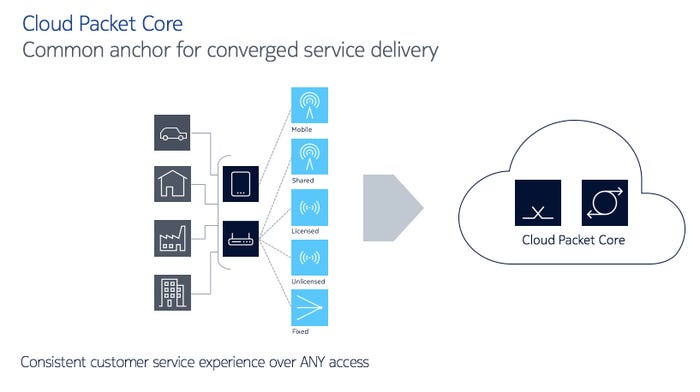A new piece of technology making access technology aggregation possible is standards-based multi-path TCP (MP-TCP) hybrid access.
August 14, 2017

Telecoms.com periodically invites expert third parties to share their views on the industry’s most pressing issues. In this piece Rob McManus, Senior Product Marketing Manager, IP and Optical Networks at Nokia, explores the potential benefits of MP-TCP hybrid access.
Communication service providers (CSPs) face significant new pressures on many fronts, often including ambitious broadband mandates set by governments worldwide. They will need to upgrade nearly every aspect of their operations to meet both political goals and daily user demands, which will, incidentally, not always align.
An intelligent multi-access network core will be the foundation for the transformation required. It will be a key piece in CSPs profitably meeting the service requirements of everything from consumer broadband to mission-critical machine-to-machine communications (MTC). Acting as a connection hub, innovation in the core is central to supporting the coming diverse range of services and their varying characteristics.
Due to economic, density and geographic considerations, no access technology will likely be sufficient in-itself to ubiquitously meet the growing consumer and enterprise demands, competitive pressures and national bandwidth mandates. Concurrent use of multi-access technology, including hybrid fixed-wireless access, will be key for a seamless ultra-broadband service experience. An intelligent and flexible core that anchors an array of multi-access technologies will ensure the delivery of converged services, addressing everything from evolving residential multimedia services, such as wireless video sharing and Netflix-bingeing, to latency sensitive real-time gaming and mission-critical applications for governments and enterprises.
Adding to the competitive challenges facing most CSPs today, governments are arming their regulators with ambitious new policy directives. Countries now see broadband network connectivity both as an economic driver and a key to social well-being, and in many geographies it is becoming an emerging human right of citizens. Although national targets differ, their goals to provide broadband speeds to every home and business are universally ambitious. Meeting these goals in denser urban areas will be hard, but the real challenge lies in the less dense, geographically dispersed rural areas of many countries that typically have poor fixed-line connectivity due to long copper loops.
In both cases, the use of multi-access technology will be required. In dense urban areas, a mix of licensed wireless spectrum enabled by CSPs’ macro and small cells, Wi-Fi and other unlicensed and shared spectrum will likely be key. In rural areas, hybrid approaches that aggregate access technologies will probably be the only way to cost-effectively meet the ambitious goals of many governments. They will also allow CSPs to address previously inaccessible customers and markets.
The capabilities of the core will need to continue to evolve and be augmented. A new piece of technology making access technology aggregation possible is standards-based multi-path TCP (MP-TCP) hybrid access. As an extension of TCP, it can be easily deployed in existing wireless and fixed access networks.
For bandwidth-intensive services and applications, MP-TCP hybrid access creates subflows that spread data for a single connection across multiple network paths. Effectively, it moves multiplexing up the stack, creating a service that is disaggregated from the underlying access technologies. A single service or application might not only be aggregated over multiple access paths, but also dynamically managed, as some paths become congested or degraded while others open up, which is all totally transparent to the service, application and end-user.

Utilizing fixed and wireless capacity with MP-TCP hybrid access
Another key piece in this transformation is the network core. It must become more efficient, flexible and ultimately programmable. Moving forward, it must be able to support high-bandwidth and low-latency services and applications directly in the places they are consumed. It needs to have robust control and protection capabilities to mitigate signaling overload, especially from internet-of-things (IoT) devices. It should make use of analytics that measure real-time user experience and adjust network resources accordingly. And it needs to be 5G-ready.
The current approach of operating and maintaining different core networks for different access technologies and services is expensive. CSPs that converge on a common core for all access types and services will be at a competitive advantage. However, to be truly cost-effective and competitive, the common multi-access core will have to be ‘cloud-native’ by design to deliver the necessary scale and flexibility to support connectivity, service and application diversity.
There are several key design principles and attributes of a cloud-native packet and 5G next-gen core. It must include software-function disaggregation. This would extend it beyond separate control and user plane functions that can be independently scaled. For increased flexibility and reliability, the software must be modularized into smaller components, which will give it the ability to dynamically scale only those functions that are necessary.
A cloud-native design also requires a state-efficient, virtual-network-function (VNF) design with a common data layer to provide the massive connectivity to support IoT/MTC while maximizing the use of compute resources.
The core will need to support and deliver service-and-application-based network slicing. For widely distributed IoT/MTC automation services, it should also be possible to distribute the core, placing it at the edge of the network to support real-time services and applications.
 A cloud-native multi-access packet core
A cloud-native multi-access packet core
An important requirement of hybrid access will be for the core to dynamically manage the multiple access paths made possible by MP-TCP. This dynamic management of resources will also have to be matched with very active bandwidth management and service-aware policing, so that the mesh of potential access paths is allocated efficiently, depending on service characteristics as well as application requirements.
For instance, as users shift their behavior over the day or evening, the CSP will need to seamlessly allocate and manage resources to match individual demand and available resources. In this way, the CSP can make the most efficient and cost-effective use of connectivity resources to meet individual needs that also match the mandated targets of the national regulator.
The cloud-native packet and 5G next-gen core will be at the heart of a global interconnected fabric connecting the world, driving digital transformation for the fourth industrial revolution, for consumer, residential and enterprise verticals as well as the move to smart cities.
Most importantly for today’s CSPs, it will provide an intelligent interconnection hub for multi-access converged service delivery. It will enable them to competitively meet both the growing appetites of consumer, residential and enterprise users and the ambitious targets set by governments globally.
Rob is responsible for product marketing of Nokia’s Cloud Packet Core. He has a BA with honors from the Open University in the UK, has published papers, and spoken at forums such as Mobile World Congress. If you need convincing about the exciting possibilities of a cloud-native and converged packet core – talk to Rob!
Read more about:
DiscussionAbout the Author(s)
You May Also Like








.png?width=300&auto=webp&quality=80&disable=upscale)


_1.jpg?width=300&auto=webp&quality=80&disable=upscale)


.png?width=800&auto=webp&quality=80&disable=upscale)